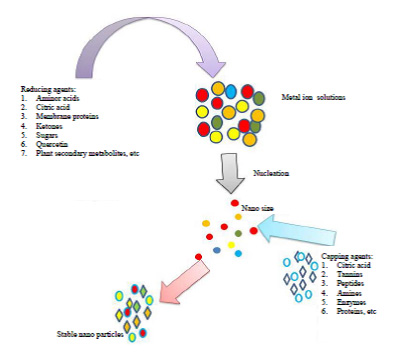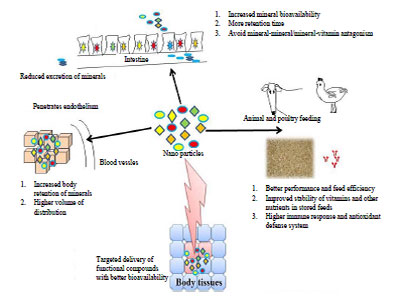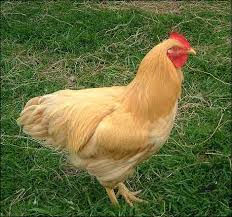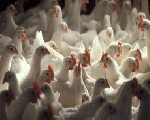The role of nanoparticles in animal and poultry nutrition

2024-05-15 12:11:05
Nanotechnology is a promising and emerging technology that has enormous potential to revolutionize the agriculture and livestock sectors globally.
The concept of nanotechnology is to change the particle size to a few particles measured in nanometers. The representation of nanoparticles with reducing agents leads to a change in the physical and chemical properties of molecules.
These nanoparticles have the ability to transport various components under different environmental conditions. Nanoparticles are now widely used in various sectors, Nutrition, Therapy, Targeted Drug production, vaccine preparations, various purification processes in textile industries, etc. Earlier, the process of synthesis of these nanoparticles by the chemical method led to the secretion of chemicals against them. Recently, the preparation of nanoparticles from plant sources referred to as green synthesis is gaining importance. Since this process involves plant extracts consisting of polysaccharides, polyphenols, irpinoids, proteins, etc. These phytochemicals act as a reducing agent to keep minerals in a reduced state during the synthesis process, their products are highly biodegradable and therefore have no negative impact on the environment. In animal nutrition, nanotechnology is mainly used in the preparation of nanometals, especially rare metals, the bioavailability of which is low. In addition, minerals such as nanoparticles reduce metal polymetallism in the intestine, thereby reducing the secretion of its antagonists and environmental pollution. Feeding nanoparticles has improved the efficiency of the digestive system, immunity and performance in cattle and poultry.
Based on their chemical properties, nanoparticles can be classified into inorganic and organic emulsions, emulsions, dispersants and nanoparticles. Inorganic nanoparticles include inorganic components at the nanoscale and are already approved for use in nutrition, for example, titanium dioxide, feed coloring can be used in the feed packaging process. As well as their intervention in the feed industry such as silicon dioxide, calcium, magnesium and silver nanoparticles for water purification and antimicrobial packaging. Organic nanoparticles include proteins, fats and sugar molecules. Organic nanoparticles by changingits nutritional efficiency but can improve their nutritional value. Organic nanoparticles can encapsulate nutrients and transport them through the digestive tract into the bloodstream with increased bioavailability, they are referred to as nanocapsules. , These capsules are intended to provide nutrients without affecting taste or appearance. As such, these coated nanomaterials are incorporated into feeds such as micelles, and liposomes, and into feed packaging systems such as biosensors, bactericidal and antimicrobial shelf life extensions.
Preparation of nanoparticles
The preparation of nanoparticles is different and depends on the purpose for which they are supposed to be. Stability of the active ingredient, toxicity. Some methods of preparation of nanoparticles are bonding and emulsification, sedimentation, spray drying, emulsion droplet coalescence, Ionic granulation and sieving method.
Green synthesis: the term green synthesis refers to the preparation of a nanomaterial by exploiting nanotechnology and plant biotechnology together such as sugar, alkalis, polyphenols, proteins, etc. These compounds additionally provide stability in ions
How nanoparticles work:
* Nanoparticles that tend to increase the surface area for better interaction with biological support
* Prolongation of the period of presence of elements in the gastrointestinal tract
* Reducing the impact of mechanisms for removing intestinal content
* Deep penetration into tissues by microcapillary
* Efficient crossing of the intestinal lining
* Enable cells to absorb efficiently
* Efficient delivery of functional compounds to target sites and thus better bioavailability

Absorption:
The absorption of nanoparticles from the digestive tract (GIT) includes in several ways, inhalation and inhalation methods, or Git rapid smart pass. The absorption, distribution, metabolism and excretion of nanoparticles in the body depend on their physical and chemical properties such as solubility, charge and volume. A particle size of less than 300 Nm can reach the bloodstream, while particles smaller than 100 Nm can reach various tissues and organs. Through the inhalation pathway, inhaled ultrafine particles can get a gateway to enter the central nervous system. But its interaction with other substances can have consequences for health and the environment. Recently, bio-nanoparticles have gained wide acceptance for the treatment of intestinal infections, as pathogen disinfection agents before transportation and processing. In addition, it has been found that D-mannose can inhibit bacterial binding to intestinal cells. Evidence through some preliminary work has shown that it accepted a specific identification of mannose receptor sites in camelobacter cells
The application of nanotechnology in animal nutrition included the use of various nanoparticles in the administration of medicines, food, probiotics, dietary supplements and other substances (Figure 2). Recently, feed additives such as rare earth minerals in the form of ultrafine particles can be effectively used to meet the requirements of minerals in livestock and poultry feed.

These nanoadditives are expected to have the advantage of better bioavailability, small dose rate and stable interaction with other components. Due to the low dose utilization, they can be used as an alternative to antibiotics as growth promoters, eliminate antibiotic residues in animal products, reduce environmental pollution and produce pollution-free animal products. Nanoadditives can also be added in micelles molecules, capsules of protein or another component of natural nutrition.
In broiler chickens, a dietary supplement of 1.20 mg per kg (Nano-Se) showed a wider range between optimal and toxic nutritional levels of nanoc with effective retention in the body compared to Sodium selenite. Also in the same study, the addition of nano-selenium (60 Nm) to fattening showed an increase in survival rate and average daily weight gain and nutritional ratio at a concentration of 0.15-1.20 milligrams per 1 kg. Nanocellulinium of 0.3 mg - 1 was found to improve the diet in terms of physiological effects.
A study on nano-zinc showed that supplementation of 0.06 ppm in the basal diet of non-broilers birds showed an improvement in immune status and bioavailability compared to inorganic zinc 38. Furthermore, various concentrations of Zn-nano molecules have been found to inhibit the growth of mycotoxic fungi (A. flavus and A. ochraceus and A. niger) and related mycotoxins (AFs, OA and Fs). This method of feed treatment can therefore be used to reduce the potential risk of mycotoxins
When broiler birds fed a nano-form of calcium phosphate by replacing up to 50% of the requirement for bicalcium phosphate, they showed the best feed conversion ratio (1.39 ± 0.02) and differed significantly from the control groups (P<0.05) 40.
Nano as a bactericidal preparation reduced the number of E. coli and streptococcal microbes, harmful salmonella, and the total number of medium-sized bacteria in the droppings. Studies have also shown that nano-silver as an additive has a positive selective effect on the number of bacteria in the digestive tract of poultry. When adding 20, 40 and 60 ppm of food, nanosilver caused a decrease in dose dependence in the weight of lymphatic organs. They noted a decrease in weight at 60 ppm of nutrition for 42 days of life. This weight reduction is associated with the antimicrobial property of N-NPs which may lead to a favorable ratio of non-pathogenic to pathogenic organisms in the intestine. The diet of chicken broilers added tosilver nanoparticles has reduced the level of hemoglobin, RBC and WBC counts43. A study conducted showed an improvement in feed intake, weight gain and feeding efficiency of broilers feeding silver nanoparticles due to the effect of ionic silver on intestinal harmful bacteria, improved intestinal health and, consequently, better nutrient absorption. And that levels higher than8 and 12 ppm of nanosilvercause hepatomegaly
Use as feed additives:
Microbeads (nanoparticles) act as carriers of essential oils, flavors, antioxidants, enzyme Q10, vitamins, minerals and Phytochemistry with improved bioavailability. Encapsulation of nanoparticles from active ingredients (such as polyphenols, minerals, micronutrients) prevents oxidative reactions. In the food industry, lipophilic nanoparticles are used to encapsulate and release nutrients, enzymes, flavors and antimicrobial compounds. Similarly, nanocapsules of additives can also be used by proteins or other components. Micelles, which are small balls of oil coated with a thin layer of polar molecules, one of which is soluble in fat and the other in water. It can be suspended in water or it can be packaged in Suspension Suspension water and suspended with oil such as ultrafine capsules containing omega-3 fish oil
Risks and dangers
The four basic stages of risk assessment include risk identification, risk characterization, exposure assessment, and risk characterization. Substances with high risk but little exposure may pose less risk than substances with limited risk and higher exposure for a longer period. Thus, it is important to prescribe the dosage and exposure time. The application of nanoparticles poses a certain danger of increased bioavailability, caused inflammation in the gastrointestinal tract, change in the bioavailability of nutrients by effects on protein and enzyme stability, possible effects on the biomass of nanoparticles in the process of heating or storage.It is assumed that the use of nanotechnology in the future will lead to a tremendous development in raising the efficiency of nutrients and increasing food conversion rates with an improvement in immunity and health of birds.
Written by A.Dr. Khaled Jafar
Professor of nutrition and Clinical Nutrition
And former dean of the Faculty of Veterinary Medicine
Former president of Sadat City University

الموضوعات المشابهه

Inflammation of the navel in chicks

Contract agriculture and its relationship to sustainable

The use of dietary nucleotides in poultry

A series of animal diseases

Diseases (infectious Bursa diseases)

Tips for broiler breeders to deal with

What to treat an animal with pneumonia..

Important information about poultry diseases

The poultry industry between the challenges of

Manufacturing a domestic product that competes with

The minister of Agriculture announces the release

Body language in chickens

Comments
Add comment